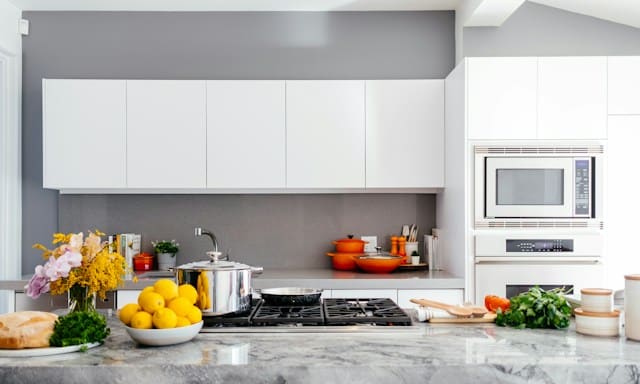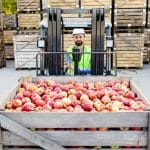As an advocate for sustainable living, you are always looking for the best ways to reduce waste. But have you ever considered that your kitchen layout could help you achieve that goal? The way your kitchen is arranged can have a significant impact on how much food and packaging waste you generate. In this article, you will find some practical tips and ideas on how to optimize your kitchen to support zero-waste cooking habits.
The Benefits of Zero-Waste Cooking
Before delving into how you can modify your kitchen layout to support zero-waste cooking, it’s crucial to understand why it’s important. At its core, zero-waste cooking is about reducing food and packaging waste. This not only benefits the environment but can also save you money and improve your health.
Cela peut vous intéresser : How can you utilize space-saving furniture and design tricks in a small living room?
Consider this: each year, an average household throws away around 30% of the food they buy. This waste not only represents a significant financial loss but also contributes to landfill pollution and greenhouse gas emissions. Reducing food waste can help alleviate these environmental problems.
Furthermore, cooking with zero waste in mind often involves buying foods in bulk and avoiding pre-packaged meals. This is not only a more sustainable way of shopping but can also encourage healthier eating habits as pre-packaged meals are often high in sodium and preservatives.
A découvrir également : What’s the best way to incorporate sustainable and reclaimed materials in a kitchen remodel?
The Importance of Reusable Containers
One of the key components to a zero-waste kitchen is the use of reusable containers. Plastic bags and packaging are a significant source of waste, and their production contributes to global warming. By using reusable containers, you can reduce the amount of plastic waste you generate and save money by buying in bulk.
The trick here is to create a space in your kitchen that accommodates these containers. You can allocate a specific cupboard or shelf for your reusable containers. Make sure this space is easily accessible, as the easier it is to use your containers, the more likely you are to do so.
Additionally, consider using clear glass containers. These will allow you to see what’s inside without having to open them, reducing the likelihood of forgetting about foods and letting them spoil. Plus, they’re much more aesthetically pleasing than plastic containers!
Setting Up a Bulk Buying Station
Bulk buying is a great way to reduce packaging waste. However, it can be a bit daunting if you’re not used to it. A well-organized bulk buying station can help make this process easier and more enjoyable.
Find a convenient location in your kitchen to set up your station. This could be a cupboard, a portion of your countertop, or even a kitchen trolley. Here, you’ll store your reusable containers, cloth bags, and other reusable shopping supplies.
Also, keep a list of the items you typically buy in bulk. This can help you avoid impulse buys and reduce food waste. And don’t forget to stock up on smaller cloth bags for items like spices or loose tea leaves.
Composting Your Kitchen Scraps
Composting is an excellent way to reduce food waste. Many foods scraps that are often thrown away, like coffee grounds or vegetable peels, can be composted. Composting these materials not only reduces the amount of waste you generate, but it also creates nutrient-rich soil that you can use in your garden.
Designate a spot in your kitchen for a compost bin. It should be easy to access but also out of the way. There are many stylish compost bins available that will blend in with your kitchen decor. Some even come with filters to prevent any unpleasant smells.
Remember, not all food scraps can be composted. Meat, dairy, and oily foods should be avoided as they can attract pests and create unpleasant odors.
Organizing Your Fridge and Pantry
Finally, keeping your fridge and pantry organized can greatly reduce food waste. How many times have you discovered a forgotten, spoiled food item at the back of your fridge? By keeping things neat and visible, you can ensure that all foods get used before they spoil.
Try to group similar items together and place older items at the front so you’ll use them first. Clear, reusable containers can be useful here as well, as you can easily see what’s inside.
Remember, a zero-waste kitchen is not only about reducing waste but also about creating a more sustainable and health-conscious lifestyle. By making a few simple changes to your kitchen layout, you can make zero-waste cooking easier and more enjoyable.
Making Sustainable Swaps
The path to a zero-waste kitchen often involves swapping out common items for more eco-friendly alternatives. You’d be surprised at how many everyday kitchen items can be replaced with more sustainable options.
Consider, for instance, your cleaning products. Many household cleaning products are filled with chemicals that are harmful to the environment and come in non-recyclable plastic packaging. Instead, opt for plant-based cleaning products that come in glass jars or other recyclable containers. This not only reduces the waste produced but also creates a healthier environment in your kitchen.
Next is your cooking utensils. Many people use plastic utensils which can easily melt or break, ending up as waste. Switching to durable materials like stainless steel or bamboo means your utensils last longer and don’t need to be replaced as often.
Paper towels are another common item in many kitchens. They are often used once and then thrown away, creating a lot of unnecessary waste. Cloth napkins or reusable kitchen towels are a good alternative, as they can be washed and used over and over again.
Remember, every little change can make a big difference in reducing waste. Plus, many of these swaps save money in the long run, making a zero-waste kitchen a win-win situation.
Valentine’s Day in a Zero-Waste Kitchen
As we are approaching Valentine’s Day, it’s a good time to consider how to celebrate this day of love in a more eco-friendly way. Cooking a romantic, zero-waste meal at home can be a unique and thoughtful way to spend this special day.
Start by planning your romantic dinner using ingredients you already have in your pantry or fridge to minimize food waste. Also, consider cooking plant-based meals as they are more sustainable and better for the environment.
Instead of using plastic or foil to wrap your heart-shaped cookies or chocolates, use reusable cloth wraps or glass jars. Not only are these more sustainable, but they also add a personal touch to your gift.
When setting the table, use cloth napkins instead of paper ones and real plates and glasses instead of disposable ones. After the meal, make sure to compost your food scraps and clean up using your eco-friendly cleaning products.
In the spirit of Valentine’s Day, remember that love is not just for people, but also for our planet. Making a conscious effort to reduce waste is one of the many ways we can show our love and care for the earth.
Conclusion
The journey to a zero-waste kitchen may seem daunting, but it doesn’t have to be. By making small changes to your kitchen layout, you can create a space that supports and encourages zero-waste cooking habits. Whether it’s through organizing your fridge and pantry, creating a bulk buying station, composting your food scraps, or making sustainable swaps, you can make a significant impact in reducing your waste.
Remember, a zero-waste kitchen isn’t just about reducing waste—it’s about creating a healthier and more sustainable lifestyle. And the journey to a zero-waste kitchen doesn’t stop in the kitchen. It extends to every area of your life, from how you shop to how you celebrate special occasions like Valentine’s Day.
So, take the first step today towards creating a low waste, eco-friendly kitchen. It’s a change that will benefit not just you, but the entire planet.











